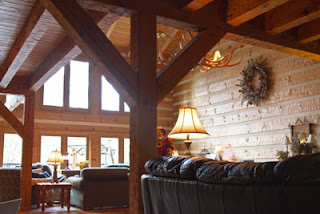When we first moved into this home, we had a lot of trouble with paper wasps building their nests all over the property. Everywhere they could find an overhang, they would build. It was always around the house, near doorways, porches or the shed door where they would be a nuisance. Then a few years ago, the number of wasps decreased to the point where they either found another place to live or they weren't such the nuisance they had been. Occasionally, I will see a small paper wasp nest under an overhang, but rarely. Here's why...

We noticed a few years ago when I got stung in the face that a colony of bald-faced hornets made a nest in my largest climbing New Dawn rose, only inches from our grill. It was a very large nest so it had been there for some time before I got stung. Of course, being so close to the place where we grilled almost daily, it had to go. To bad. I had asked a friend what they were and he informed us that they were a quiet beneficial insect that prayed mostly on paper wasps and other destructive insects. I hated to do what we did to them, but they had to go. Paper wasps returned to the garden.
The following year, they were found in the top of one of the maple trees. Our tree trimmer found them and refused to prune that tree. Understandable. However, because they were at the top of the 10 foot tree, they were allowed to remain there, not being a problem with stinging. There were no paper wasps in the garden that year. By November of that year, the nest had long been abandoned and was blown from the tree in a stiff wind.
The year after that, they decided to make a nest in my vegetable garden, near the ground. We couldn't harvest the strawberries without being stung numerous times. They had to go again. Once again paper wasps returned to the garden.
This year, I found a fine, very, very large bald-faced hornet nest deep inside the Star Magnolia. This nest is even larger than the one we found in the New Dawn rose - about the size of two human heads put together. It's been there undetected all summer and just increased in size over this time. I stood and watched the activity around it for a bit and realized that the hornets were using a hole deep within the tree to enter and leave. It would be very hard for any person to get that far inside the magnolia.
I had to tell Husband about the nest and he got upset. "I was working really close to that spot pulling weeds," he said. I told him to be careful around the area and don't do anything to dislodge the nest or disrupt it in any way and he will be fine. He was insistent that it had to go. I hope I talked him into leaving it alone. Even with hornet spray, there's no way you could destroy this size nest without taking on a lot of battle scars. I do prefer that they keep their nests at the top of the larger trees, but this one really isn't in the way and should be left alone. Besides, they do keep the destructive bug population down a good bit.
September is coming and the temperatures are going to be dropping. They will leave the nest and hibernate underground for the winter. The nest will be abandoned forever. They've lived here this long without incident and hopefully will be able to live the rest of the summer quietly. At least I hope so. Most of the work for that garden bed is done for the year. It won't be until early spring when we go there again to prepare it for next year's growth. The only work around that area is mowing that will be several feet away from the nest once a week or less depending on the rain. Since the hornets enter the nest from inside the tree, no one, even the mower will get close enough to upset them.
I have seen a nest that was even larger than this one, near the top of a 80 foot dying tree. These insects are incredible and having them in the garden isn't a bad thing. Just when they choose a bad spot to start a nest. Next year, they will find another place to build and hopefully it will be at the top of one of our larger trees. Up there, they will be left completely alone, to live their lives and do their thing without consequence. I like what they do for my garden - the way they keep it clean of destructive insects, but I can't have them where I work a lot.
They've been living in this garden for the past 4 years and I hope they continue to stay. Each year it is interesting to see where they decide to build a nest and I can only hope they choose a spot where I won't find them a nuisance. They are usually quite quiet and don't get upset if you meet them in the garden away from their nest. Their protective instincts, however, can cause problems in more high traffic areas.


































